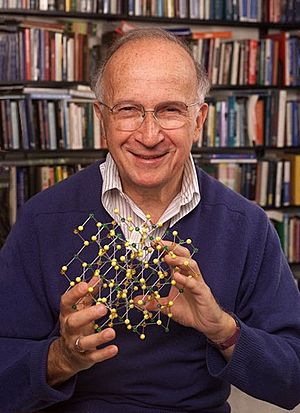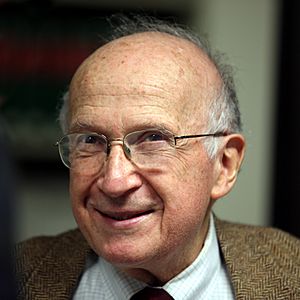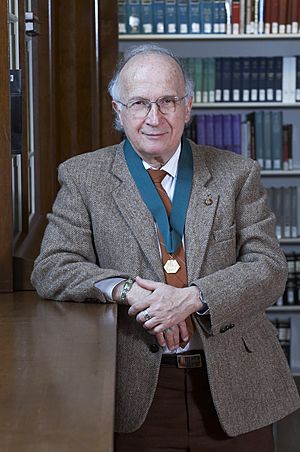Roald Hoffmann facts for kids
Quick facts for kids
Roald Hoffmann
|
|
|---|---|

Roald Hoffmann (2009)
|
|
| Born |
Roald Safran
July 18, 1937 Złoczów, Poland
|
| Nationality | American |
| Citizenship | United States |
| Alma mater | Stuyvesant High School Columbia Harvard |
| Known for | Woodward–Hoffmann rules Extended Hückel method Isolobal principle |
| Spouse(s) |
Eva Börjesson
(m. 1960) |
| Children | Two |
| Awards |
|
| Scientific career | |
| Fields | Theoretical Chemistry |
| Institutions | Cornell University |
| Thesis | Theory of Polyhedral Molecules: Second Quantization and Hypochromism in Helices. (1962) |
| Doctoral advisor |
|
| Doctoral students | Jing Li |
| Other notable students | Jeffrey R. Long (undergraduate), Karen Goldberg (undergraduate) |
Roald Hoffmann (born Roald Safran; July 18, 1937) is a Polish-American theoretical chemist who won the 1981 Nobel Prize in Chemistry. He has also published plays and poetry. He is the Frank H. T. Rhodes Professor of Humane Letters, emeritus, at Cornell University, in Ithaca, New York.
Contents
Early life
Escape from the Holocaust
Hoffmann was born in Złoczów, Poland (now Zolochiv, Ukraine), to a Polish-Jewish family, and was named in honor of the Norwegian explorer Roald Amundsen. His parents were Clara (Rosen), a teacher, and Hillel Safran, a civil engineer. After Germany invaded Poland and occupied the town, his family was placed in a labor camp where his father, who was familiar with much of the local infrastructure, was a valued prisoner. As the situation grew more dangerous, with prisoners being transferred to extermination camps, the family bribed guards to allow an escape. They arranged with a Ukrainian neighbor named Mykola Dyuk for Hoffmann, his mother, two uncles and an aunt to hide in the attic and a storeroom of the local schoolhouse, where they remained for eighteen months, from January 1943 to June 1944, while Hoffmann was aged 5 to 7.
His father remained at the labor camp, but was able to occasionally visit, until he was tortured and killed by the Germans for his involvement in a plot to arm the camp prisoners. When she received the news, his mother attempted to contain her sorrow by writing down her feelings in a notebook her husband had been using to take notes on a relativity textbook he had been reading. While in hiding his mother kept Hoffmann entertained by teaching him to read and having him memorize geography from textbooks stored in the attic, then quizzing him on it. He referred to the experience as having been enveloped in a cocoon of love. In 1944 they moved to Kraków where his mother remarried. They adopted her new husband's surname Hoffmann.
Most of the rest of the family was killed in the Holocaust, though one grandmother and a few others survived. They migrated to the United States on the troop carrier Ernie Pyle in 1949.
Hoffmann visited Zolochiv with his adult son (by then a parent of a five-year-old) in 2006 and found that the attic where he had hidden was still intact, but the storeroom had been incorporated, ironically enough, into a chemistry classroom. In 2009, a monument to Holocaust victims was built in Zolochiv on Hoffmann's initiative.
Personal life
Hoffmann married Eva Börjesson in 1960. They have two children, Hillel Jan and Ingrid Helena.
He is an atheist.
Education and academic credentials
Hoffmann graduated in 1955 from New York City's Stuyvesant High School, where he won a Westinghouse science scholarship. He received his Bachelor of Arts degree at Columbia University (Columbia College) in 1958. He earned his Master of Arts degree in 1960 from Harvard University. He earned his doctor of philosophy degree from Harvard University while working under joint supervision of Martin Gouterman and subsequent 1976 Nobel Prize in Chemistry winner William N. Lipscomb, Jr. Hoffman worked on the molecular orbital theory of polyhedral molecules. Under Lipscomb's direction the Extended Hückel method was developed by Lawrence Lohr and by Roald Hoffmann. This method was later extended by Hoffmann. He went to Cornell in 1965 and has remained there, becoming professor emeritus.
Scientific research
Hoffmann's research and interests have been in the electronic structure of stable and unstable molecules, and in the study of transition states in reactions. He has investigated the structure and reactivity of both organic and inorganic molecules, and examined problems in organo-metallic and solid-state chemistry. Hoffman has developed semiempirical and nonempirical computational tools and methods such as the extended Hückel method which he proposed in 1963 for determining molecular orbitals.
With Robert Burns Woodward he developed the Woodward–Hoffmann rules for elucidating reaction mechanisms and their stereochemistry. They realized that chemical transformations could be approximately predicted from subtle symmetries and asymmetries in the electron orbitals of complex molecules. Their rules predict differing outcomes, such as the types of products that will be formed when two compounds are activated by heat compared with those produced under activation by light. For this work Hoffmann received the 1981 Nobel Prize in chemistry, sharing it with Japanese chemist Kenichi Fukui, who had independently resolved similar issues. (Woodward was not included in the prize, which is given only to living persons, although he had won the 1965 prize for other work.) In his Nobel Lecture, Hoffmann introduced the isolobal analogy for predicting the bonding properties of organometallic compounds.
Some of Hoffman's most recent work, with Neil Ashcroft and Vanessa Labet, examines bonding in matter under extreme high pressure.
What gives me the greatest joy in this work? That as we tease apart what goes on in hydrogen under pressures such as those that one finds at the center of the earth, two explanations subtly contend with each other ... [physical and chemical] ... Hydrogen under extreme pressure is doing just what an inorganic molecule at 1 atmosphere does!
Artistic interests
The World Of Chemistry with Roald Hoffmann
In 1988 Hoffmann became the series host in a 26-program PBS education series by Annenberg/CPB, The World of Chemistry, opposite with series demonstrator Don Showalter. While Hoffmann introduced a series of concepts and ideas, Showalter provided a series of demonstrations and other visual representations to help students and viewers to better understand the information.
Entertaining Science
Since the spring of 2001, Hoffmann has been the host of the monthly series Entertaining Science at New York City's Cornelia Street Cafe, which explores the juncture between the arts and science.
Non-fiction
He has published books on the connections between art and science: Roald Hoffmann on the Philosophy, Art, and Science of Chemistry and Beyond the Finite: The Sublime in Art and Science.
Poetry
Hoffmann is also a writer of poetry. His collections include The Metamict State (1987, ISBN: 0-8130-0869-7), Gaps and Verges (1990, ISBN: 0-8130-0943-X), and Chemistry Imagined, co-produced with artist Vivian Torrence.
Plays
He co-authored with Carl Djerassi the play Oxygen, about the discovery of oxygen and the experience of being a scientist. Hoffman's play, "Should've" (2006) about ethics in science and art, has been produced in workshops, as has a play based on his experiences in the holocaust, "We Have Something That Belongs to You" (2009), later retitled "Something That Belongs to You.
Honors and awards
Nobel Prize in Chemistry
In 1981, Hoffmann received the Nobel Prize in Chemistry, which he shared with Kenichi Fukui "for their theories, developed independently, concerning the course of chemical reactions".
Other awards
Hoffmann has won many other awards, and is the recipient of more than 25 honorary degrees.
- ACS Award in Pure Chemistry, 1969
- Award of the International Academy of Quantum Molecular Science, 1970, "pour sa methode de calcul des fonctions d'onde moleculaires et pour ses etudes theoriques des reactions chimiques"
- Fellow of the American Academy of Arts and Sciences, elected 1971
- Elected member of the National Academy of Sciences, elected 1972
- Arthur C. Cope Award in Organic Chemistry, 1973 (with Robert B. Woodward)
- Nobel Prize in Chemistry, 1981
- Inorganic Chemistry Award (American Chemical Society), 1982 (sponsored by Monsanto)
- National Medal of Science, 1983
- Fellow of the American Philosophical Society, elected 1984
- Elected a Foreign Member of the Royal Society (ForMemRS) in 1984
- Foreign Member of the Royal Swedish Academy of Sciences, elected 1985
- Foreign Member of the Finnish Society of Sciences and Letters, elected 1988
- Priestley Medal, 1990
- Harvard Centennial Medalist, 1994
- Pimentel Award in Chemical Education, 1996
- E.A. Wood Science Writing Award, 1997
- Literaturpreis of the Verband der Chemischen Industrie for his textbook The Same and Not The Same, 1997
- Kolos Medal, 1998
- American Institute of Chemists Gold Medal, 2006
- James T. Grady-James H. Stack Award for Interpreting Chemistry, 2009
- Fellow of the American Chemical Society, 2009
- Fellow of the Kosciuszko Foundation of Eminent Scientists of Polish Origin and Ancestry, 2014
- Ullyot Public Affairs Lecture, Science History Institute, 2019
- Marie Curie Medal of the Polish Chemical Society, 2019
Hoffmann is a member of the International Academy of Quantum Molecular Science and the Board of Sponsors of The Bulletin of the Atomic Scientists.
In August 2007, the American Chemical Society held a symposium at its biannual national meeting to honor Hoffmann's 70th birthday.
In 2008, the Göttingen Academy of Sciences and Humanities awarded him its Lichtenberg Medal.
In August 2017, another symposium was held at the 254th American Chemical Society National Meeting in Washington DC, to honor Hoffmann's 80th birthday.
The Hoffmann Institute of Advanced Materials in Shenzhen, named after him, was founded in his honor in February 2018 and formally opened in his presence in May 2019.
See also
 In Spanish: Roald Hoffmann para niños
In Spanish: Roald Hoffmann para niños
- List of Jewish Nobel laureates



